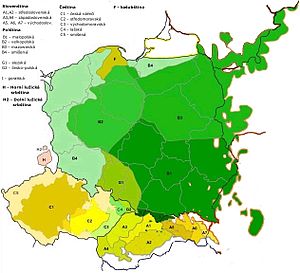Czech-Slovak languages
| Czech–Slovak | |
|---|---|
| Geographic distribution: |
Central Europe |
| Linguistic classification: |
Indo-European
|
| Subdivisions: | |
| Glottolog: | czec1260 |

Czech–Slovak within West Slavic
|
|
The Czech and Slovak languages form the Czech–Slovak (or Czecho–Slovak) subgroup within the West Slavic languages.
Most varieties of Czech and Slovak are mutually intelligible, forming a dialect continuum (spanning the intermediate Moravian dialects) rather than two clearly distinct languages; the eastern Slovak dialects are more divergent and form a dialect continuum with the Lechitic subgroup of West Slavic, most notably Polish.
The name Czechoslovak language is mostly reserved for an official written standard intended to unify Czech and Slovak created in the 19th century (but to a greater extent based on Czech rather than Slovak).
The early Slavic expansion reached Central Europe in c. the 7th century, and the West Slavic dialects diverged from Common Slavic over the following centuries. The West Slavic tribes settled on the eastern fringes of the Carolingian Empire, along the Limes Saxoniae. Prior to the Magyar invasion of Pannonia in the 890s, the West Slavic polity of Great Moravia spanned much of Central Europe between what is now Eastern Germany and Western Romania. In the high medieval period, the West Slavic tribes were again pushed to the east by the incipient German Ostsiedlung, decisively so following the Wendish Crusade in the 11th century.
West Slavic as a group distinct from Common Slavic thus emerges during the 7th to 9th centuries. The Czech-Slovak in turn develops as a separate dialect continuum within West Slavic during roughly the 10th to 12th centuries, just predating the first written attestation of the language in the 13th to 14th centuries. The diversification of West Slavic had the characteristic of a dialect continuum. For example, the spirantisation of Slavic /g/ to /h/ is an areal feature shared by the Czech-Slovak group with both Ukrainian and Sorbian (but not with Polish). This innovation appears to have travelled from east to west, and is sometimes attributed to contact with Scytho-Sarmatian. It is approximately dated to the 12th century in Slovak, the 12th to 13th century in Czech and the 14th century in Upper Sorbian.
...
Wikipedia
